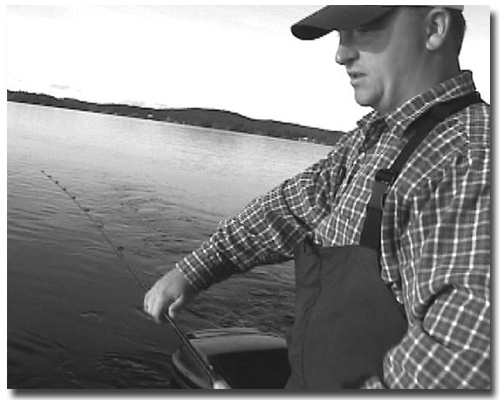|
[?]Subscribe To This Site
|
Trolling Leadcore on
|
| Month | Salmon (depth & lure) | Lakers (depth & lure) | Rainbow (depth & lure) |
| May - October | Trolling 5-20 ft. Hardware color depends on the day, but copper, gold and orange variations are all effective. | Drag live bait on bottom in early season and use white, copper and orange spoons just off the bottom in deep holes late in the season. | |
| Ice fishing | 2-3 ft. under the ice | Right on the bottom |
- My Largest Salmon, laker, rainbow, and bass I have caught in Lake Winni?
Salmon:
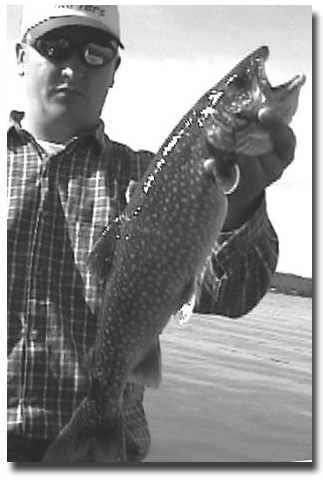
Size: 6.5 pounds in April
Lure: live smelt with 3 colors of leadcore with 100 ft. mono leader
Laker:
Size: 7 pounds in May
Lure: live smelt, dragging bottom with leadcore line
Depth: 35 ft.
Largemouth Bass:
Size: 6.9 pounds
Lure: live bait with leadcore line
Depth: on bottom
- Passing on to others my angling skills?
I do this constantly in my professional guiding. Customers are always asking questions, and I enjoy passing my knowledge of fishing onto others and helping them succeed.
I'm also active on the Web, passing on to others my latest tips about leadcore, how deep I'm getting them, what lures. The only thing I do not broadcast is where I’m catching them. Being a professional guide on Lake Winni, I do not want to have my guests be mobbed with too many anglers!
- My top 5 tips for salmon, lakers and rainbows?
- Get out there early. Many anglers get a late start, and I will have already landed several fish by the time some get out.
- Change what you do. Do not just run what you always run and fish where you always fish. If they’re not hitting, try something else; if that doesn't work, move! I always try to fish around baitfish. I will turn on my fish finder and just cruise an area before I even set up. I’m looking for smelt. If I find what I’m looking for, then I'll use leadcore and fish that area.
- Learn the seasons and the body of water that you fish. Fish do different things in different times of year and in different bodies of water. When do the smelt spawn and where? How deep should you fish in the fall and why? If you really want to be a good fisherman there is much that goes in to it -- lots to learn. Educate yourself on the body of water, the feed of species you target, water temps, thermocline, water color, weather, currents, trolling speeds, scents, size, and structure of the lake.
- Lure speed and action. Pay attention to your lure, making sure it is doing what it should and troll at the speeds that you should be for what you are running be it a fly, live bait, hardware, leadcore or dodgers.
- Ask questions and read up on fishing. I often find myself, when telling people about different tips and techniques, sharing with them tips I have learned about leadcore and other fishing methods or read from others. I ask questions and I read, because it is fun to learn.
Everyone has a variation on how they fish and what they do. What they do may not work for you. However, both reading and asking others can be productive and you can learn so much! Reading books like Hal’s, which offers 600 years of angling wisdom from 15 Master Anglers, is a great short-cut which can save you years of learning the hard way.
And now web sites, like mine are appearing which are also excellent sources of information. On my site, I have added a Message Board where people share stories and angling tips including whether they use fly rod, leadcore or down rigger. It's fun and most definitely educational.
- My top 5 tips for bass?
- Once again, it is most important to educate yourself to the body of water that you are fishing. Since this is about Lake Winni, I'll share my tips for it.
- Know what the bass do in different times of the year. This is by far the best tip I can give. What works in the spring is not necessarily going to work in the late summer months.
- Match your line with the water. Lake Winni is a clear lake and you should match the clarity of the water with the pound test of the line that you are going to use. When smallmouth bass fishing I use 8 to 12-pound test line. If you were fishing down south, people would look at you like you had two heads if you told them you were going to fish line that light!
- Keep it simple. A good friend of mine is one of the best bass fishermen on Lake Winni. This tip is one he always tells me: "Keep it simple." For example when we fish in a tournament, I’ll want to bring all kinds of different baits and he will scold me saying, “just bring what you have confidence in."
- Fish the structure. Lake Winni has incredible structure. Utilize it, finding some good humps with grass and rocks. In the summer and early fall months, fish these spots. Have more than one spot to fish. If I fish a spot and there is everything I want such as right depth, good grass and rocks, but no bait, I will move to another spot until I find bait and fish there.
- My top 5 ice fishing tips?
- Again, it really depends upon what you are targeting for species. However, the basics are a good start. Always make sure you are using the right pound test line and that it is good and strong. Don’t neglect your equipment.
Change your line from time to time and keep it fresh. I usually rig all my lines and jig rods with 8#. green mono with a 6# fluorocarbon leader. We usually fish for white perch when ice fishing; however we will also fish for trout.
- When fishing for white perch you should first fish in the correct depth of water 20 - 40 feet seems to work for us. We have found that the mouths of coves seem to be pretty productive fishing spots, two feet off the bottom with live smelt.
White perch are a school fish (they run in large groups.) If we find a “hot hole,” we will pull the tip-ups out and begin to jig with either a small Swedish Pimple or just a dead smelt. Sometimes you can fill a 5-gallon pail in just a few minutes when you find one of these “hot holes!"
And once again, if you set up and are not catching anything, move! They run in schools and you may make one small move and then suddenly you are into them!
- Lake Trout: When ice fishing for lake trout, I prefer to jig. I use buck-tail jigs. Red and white are my favorite colors. I use cut sucker bait to dress the hook and give the jig a little more action and smell.
You can catch lake trout in almost any depth of water; however I like 40 to 50 feet and I try to fish a sandy bottom on the edge of a deeper water drop-off. When I jig, I just move the line a little, almost fanning the bottom of the lake.
I also like to chum the hole with chopped up fish. On Lake Winni, you are allowed two holes so with the one that I’m not jigging, I will fish a piece of sucker right on the bottom.
- Rainbow Trout: This can be a great deal of work, but also productive. I like to fish a sandy bottom in 2-6 feet of water; I will drill several holes in a line (10-15) than chum each hole with 4-5 salmon eggs. I then will rig a jig rod with a small hook and a pin smelt.
I also will have a tip up in, with a small smelt or power bait just under the ice. I will run around peeking in the holes counting the salmon eggs and if I find any missing I plop my smelt in that hole. This can be productive and a pain in the butt.
- Use your head. Since all I ice fish for is the top 3 species, my last tip is one that I like to practice when guiding. When I have customers hooked up with fish, I always tell them, “enjoy yourself.” I say this because that is why we are fishing - to have fun and to enjoy ourselves.
You are going to lose fish and you are going to make mistakes, so try not to get discouraged. Just have fun, keep fishing, and enjoy "The Smile of the Great Spirit!"
- Catch and Release?
For the most part, I do practice catch and release. When I’m guiding, if people want to keep fish, then we keep fish. When fun fishing, as I call it, we usually release all of them, unless we hurt a fish.
I see nothing wrong with keeping fish to eat. I believe in the work of the New Hampshire Fish and Game biologists and I believe that they would set smaller bag limits if that were necessary.
- What do I think has happened to the yellow perch?
If I had to come up with a guess about the yellow perch, I know that Lake Winnipesaukee in New Hampshire has been cleaned up quite a bit from the past and the yellow perch may just not have the forage that they had in the past.
- My favorite fishing stories?
I have many stories but this one ties in to a couple of my previous answers. I spoke of my good fishing friend, Steve. Steve and I love to fish Squam Lake and we use to do very well there. Much like any other day, Steve and I fished the lake in his 14-foot rowboat equipped with a 9.9 kicker and leadcore rods.
We met at my house early in the morning. Then we piled my leadcore rods and tackle into his truck and headed off. Sipping coffee and rubbing sleepy eyes, we drove from my house in Center Harbor, which was just up the hill from Steve’s, to Sandwich Beach on Squam Lake in New Hampshire.
When we launched the boat there, the water was flat and the summer fog was just lifting off the water. We trolled out in front of the beach, working a couple of good humps. The sun was not even peeking up over the mountains that surround this beautiful lake as we began to set up our leadcore lines.
Steve had one clamp-on Big Jon down rigger and we would usually run a rod off the ball and run a stacker line above that. Off each side of the boat we would run a leadcore rod which we would hold, since there were no rod holders.
When we first started fishing together, I loved to fish with my favorite lure, a Sutton spoon in copper and silver, #44. But Steve hated Sutton spoons. (Steve has a dog, which he named "Sutton.") Enough said. After a few minutes we landed our first fish with leadcore, a nice three-pound Salmon. This fish was just one of several more to come.
Around six in the morning, we started to notice a couple of other boats that were fishing in the area beginning to come closer. Finally, a man in one of the boats hollered over, "What are you guys using?" We told him how deep, what lures and that we were using leadcore. These honest tips must not have helped very much as we never saw any of the boats around us land a fish.
We ended the day around 10 AM and landing 12 nice fish. Not a bad day for two kids in a 14 foot rowboat! Later that day, with a couple of the nice fish we had caught, we went to one of the local bait shops, as we loved to show off our success.
We were there for awhile, when a couple of guys came in telling tall tales about these two kids in a rowboat this morning at Squam Lake. The men were saying how every time they passed them, the boys had a fish on …or even a double. The men were complaining that there seemed to be no fish since they didn't have a strike.
Steve asked, "What did the two kids look like and where were you fishing?" One of the guys replied, "Over by Sandwich Beach, and they were both wearing baseball hats." Steve than asked, "Like this?" and tilted his hat a bit. The guy caught on, “That was you two!” pointing at Steve and me.
We confessed that it was the two of us, and we began giving the guy some tips and ideas for his next trip. The two guys just could not believe that we caught so many fish with leadcore when they had not a strike. They looked at us with an amazed look in their eyes.
I love this story because these gentlemen had a big fancy high-tech boat with four electric downriggers and Steve and I just had his little rowboat. It was a great feeling of triumph! It was also nice to be in a position to help the men. I hope they had better luck the next day.
To order the complete award-winning book, Angling in the Smile of the Great Spirit, or its accompanying DVDs featuring live interviews with the Master Anglers of Lake Winni, please go to: www.deepwaterspress.com






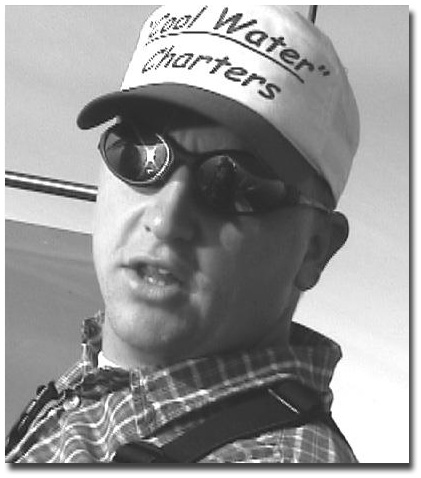
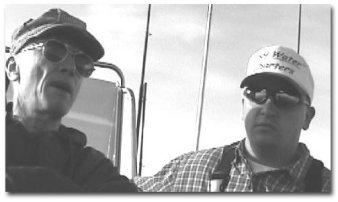
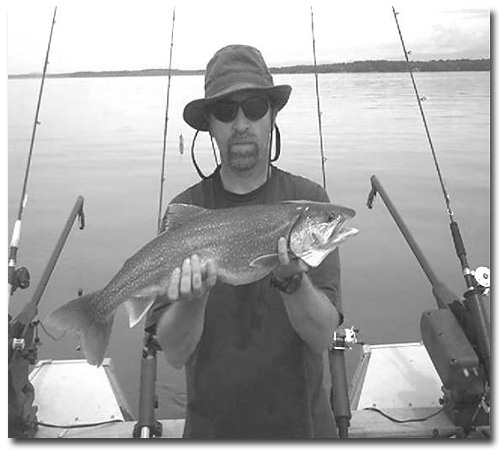 me being the sportsman that I am today. He always took me both hunting and fishing and if the “guys” were going and they didn’t want the children to go, then my father would stay behind with me.
me being the sportsman that I am today. He always took me both hunting and fishing and if the “guys” were going and they didn’t want the children to go, then my father would stay behind with me.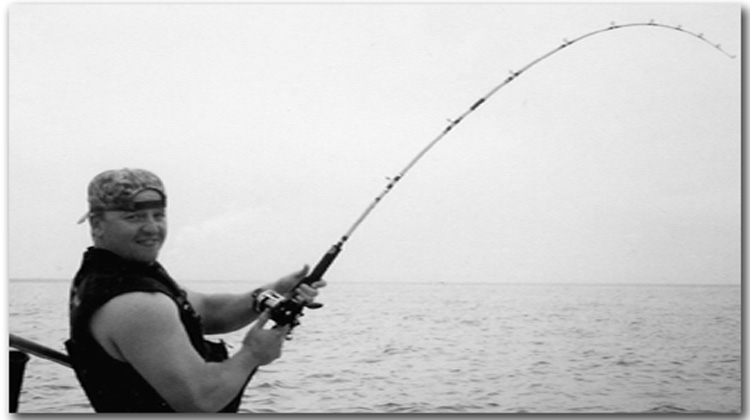 t is May 10th. You and two close friends have nothing to do all day except fish. It's five in the morning; the water is flat as ice and salmon are rising around your boat like mackerel in a feeding frenzy. All you can hear is the soft chug-chug of the motor and the drag of your leadcore and maybe occasional loon music.
t is May 10th. You and two close friends have nothing to do all day except fish. It's five in the morning; the water is flat as ice and salmon are rising around your boat like mackerel in a feeding frenzy. All you can hear is the soft chug-chug of the motor and the drag of your leadcore and maybe occasional loon music. 